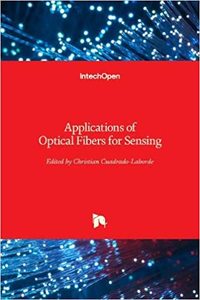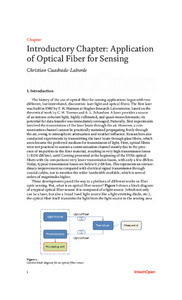Por favor, use este identificador para citar o enlazar este ítem:
https://repositorio.uca.edu.ar/handle/123456789/12556| Campo DC | Valor | Lengua/Idioma |
|---|---|---|
| dc.contributor.author | Cuadrado-Laborde, Christian | es |
| dc.date.accessioned | 2021-10-26T16:27:07Z | - |
| dc.date.available | 2021-10-26T16:27:07Z | - |
| dc.date.issued | 2019 | - |
| dc.identifier.citation | Cuadrado-Laborde, C. Introductory chapter : application of optical fiber for sensing [en línea]. En: Cuadrado-Laborde, C. (ed.). Applications of Optical Fibers for Sensing. Londres : IntechOpen Limited, 2019. doi: 10.5772/intechopen.83623. Disponible en: https://repositorio.uca.edu.ar/handle/123456789/12556 | es |
| dc.identifier.isbn | 978-1-78985-352-0 | - |
| dc.identifier.uri | https://repositorio.uca.edu.ar/handle/123456789/12556 | - |
| dc.description.abstract | 1. Introduction The history of the use of optical fiber for sensing applications began with two different, but interrelated, discoveries: laser light and optical fibers. The first laser was built in 1960 by T. H. Maiman at Hughes Research Laboratories, based on the theoretical work by C. H. Townes and A. L. Schawlow. A laser provides a source of an intense coherent light, highly collimated, and quasi-monochromatic; its potential for data transfer was immediately envisaged. Naturally, first experiments involved the transmission of the laser beam through the air. However, a communication channel cannot be practically sustained propagating freely through the air, owing to atmospheric attenuation and weather influence. Researchers also conducted experiments by transmitting the laser beam through glass fibers, which soon became the preferred medium for transmission of light. First, optical fibers were not practical to sustain a communication channel mainly due to the presence of impurities in the fiber material, resulting in very high transmission losses (>1000 dB/km), until Corning presented at the beginning of the 1970s optical fibers with (in comparison) very lower transmission losses, with only a few dB/km. Today, typical transmission losses are below 0.2 dB/km. This represents an extraordinary improvement as compared with electrical signal transmission through coaxial cables, not to mention the wider bandwidth available, which is several orders of magnitudes higher. | es |
| dc.format | application/pdf | es |
| dc.language.iso | eng | es |
| dc.publisher | IntechOpen | es |
| dc.rights | Acceso abierto | * |
| dc.rights.uri | http://creativecommons.org/licenses/by-nc-sa/4.0/ | * |
| dc.source | Cuadrado-Laborde, C. (ed.). Applications of Optical Fibers for Sensing. Londres : IntechOpen Limited, 2021 | es |
| dc.subject | FIBRA OPTICA | es |
| dc.subject | LUZ | es |
| dc.subject | LASER | es |
| dc.subject | SENSORES | es |
| dc.subject | INGENIERIA ELECTRONICA | es |
| dc.title | Introductory chapter : application of optical fiber for sensing | es |
| dc.type | Parte de libro | es |
| dc.identifier.doi | 10.5772/intechopen.83623 | - |
| uca.disciplina | INGENIERIA | es |
| uca.issnrd | 1 | es |
| uca.affiliation | Fil: Cuadrado-Laborde, Christian. Universidad Nacional de Rosario. Facultad de Ciencias Exactas, Ingeniería y Agrimensura. Instituto de Física Rosario; Argentina | es |
| uca.affiliation | Fil: Cuadrado-Laborde, Christian. Consejo Nacional de Investigaciones Científicas y Técnicas; Argentina | es |
| uca.version | publishedVersion | es |
| item.grantfulltext | open | - |
| item.languageiso639-1 | en | - |
| item.fulltext | With Fulltext | - |
| Aparece en las colecciones: | Libros/partes de libro | |
Ficheros en este ítem:
| Fichero | Descripción | Tamaño | Formato | |
|---|---|---|---|---|
| portada (3).jpg | 24,41 kB | JPEG |  Visualizar/Abrir | |
| introductory-chapter-application.pdf | 730,39 kB | Adobe PDF |  Visualizar/Abrir |
Visualizaciones de página(s)
81
comprobado en 27-abr-2024
Descarga(s)
258
comprobado en 27-abr-2024
Google ScholarTM
Ver en Google Scholar
Altmetric
Altmetric
Este ítem está sujeto a una Licencia Creative Commons

